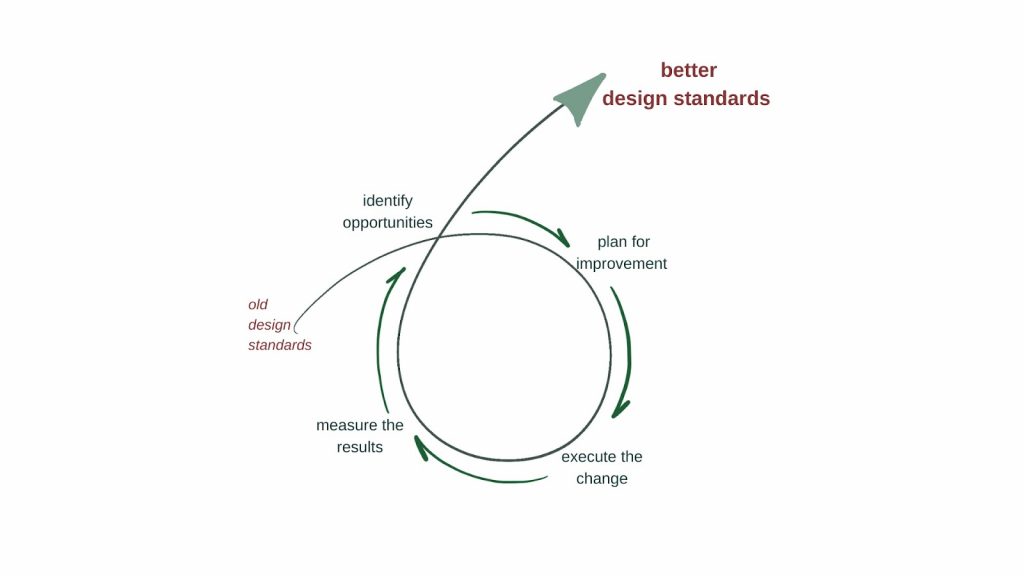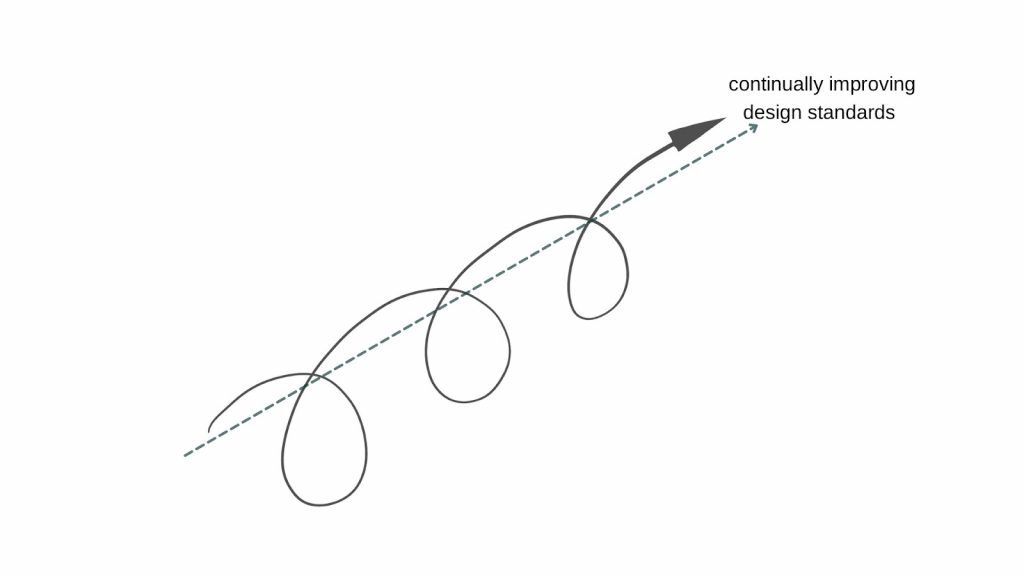
Build, manage, and share your firm’s design standards with ease. Manage FF&E specification, procurement, and product data at scale. Take on bigger projects with confidence and grow your firm with Fohlio. Schedule a demo or book a consultation with one of our account managers to explore these features today.
Editor’s note: This is part 2 (using design standards) of our 6-part series on success metrics for the design and construction industry. Check out parts 1 (How to Grow Your Firm in 2022: Five Metrics of Success for the Design and Construction Industry) and 3 (How to Keep Your Project Data Monitored and Documented).
On the surface, design is creative work. But we know better: As a profession, the success of design work must be measured, just like any other industry.
This is especially true for large projects like institutions (public utilities), franchises (hotel brands), or anything else that requires massive repetition (spec homes).
So what makes for successful design? And how do design standards increase the likelihood of success?
What are design standards and why should you care?
Let’s start with defining design standards. Also referred to by a host of other names (like design guidelines), design standards serve as the baseline for all the criteria and constraints to be fulfilled and adhered to in a project.
Standards help designers make the best possible choices in the shortest possible time. It ensures that the specifications of materials, measurements, performance, and assembly techniques adhere to expectations set by stakeholders involved in a project.
With design standards, you can optimize the economies of scale, make materials transposable, and define a roadmap for effective, tried- and- tested solutions.
Learn more: How to Get Started on Institutional Design Standards: The Good, The Bad, and Why You Should Do It Anyway
There’s no lack of benefits to convince design firms that standards are a good idea, because they help:
- Achieve the same operating functionality for multiple projects.
- Ensure uniformity in quality.
- Create and enforce a signature look for your brand.
- Improve agility and increase productivity for your team.
- Reduce project waste.
- Increase customer satisfaction.
- Increase profit.
And when design standards are backed by an online materials library, they also make specification workflows efficient and powerful.
“Design work doesn’t just satisfy requirements, it elicits them.”
-Fred Brooks
Learn more: 9 Ways a Digital Materials Library Can Take Your Firm to the Next Level
How to measure design success
Next, let’s define success. Aesthetic can be vague and subjective, so let’s not rely on that. Instead, let’s use more objective metrics like:
- Client satisfaction
- Cost effectiveness
- Time spent
- Longevity
- Lifetime cost
These factors provide a tangible, objective, and measurable way of determining success. Of course, there’s no hard and fast rule: The definition of success is largely determined by each firm, but this is a good start.
Learn more: How to Grow Your Firm: Five Metrics of Success for the Design and Construction Industry
How to use design standards to improve project success
The foremost requisite of creating standards is to set the bar for your design, ensuring you hit all the metrics of success. Essentially, standards are a collection of the best methods and choices that have been discovered to be most effective for the implementation of your design. Design standards create a systematic approach that continually assesses the design holistically. We found that applying the continuous improvement or kaizen cycle, could be an efficient solution for identifying better design choices and methodologies. (See exhibit A)

Exhibit A) The continuous improvement cycle
Here’s an example of continuous improvement in action.
1 – Identify opportunities.
Problems are opportunities in disguise. It forces you, the designer or construction professional, to take a hard look at the choices you are making. Ask yourself: Which parts of the project need the most improvement (whether it be a design method, or even something as simple as material choices)? What part, if modified, will significantly improve the chances of success in a project? These questions will help you in identifying opportunities for improvement in your project.
Example: The developer of a set of seaside apartments finds herself getting complaints from clients about the laminate flooring specified for the kitchen area. These clients had one common problem: bubbling. As it turns out, the designer had forgotten that her clients’ apartments were set in a humid area, and that laminate flooring does not do well in wet areas (like kitchens and bathrooms), and will produce bubbles if it absorbs moisture. This bubbling eventually encouraged the growth of mold, which is a health hazard and could result in potential lawsuits.
2 – Plan for improvement.
This next step is basically just you, looking for the best solution possible. Finding the best solution possible means coming up with a solution that addresses not only the problem at hand but also all other considerations (aesthetic, durability, availability, affordability, performance, longevity) involved in coming up with a solution.
The clients loved the look and feel of the tiles but did not think that it was a safe material choice. Anne had then opted to place in a subfloor moisture barrier, but through experience, she recollected that this would only last 3-4 years until the laminate flooring would begin to show signs of damage again. She then started looking for alternate flooring options and came up with wood-looking porcelain tiles. Porcelain tiles have a life cycle of 10-15 years and would still give her clients the rustic and organic look of wood flooring without the inconvenience and molds.
3 – Execute your findings.
Once you have considered all the variables, execute your findings.
Anne then presented her clients with 2 quotes, the first quote keeping the laminate flooring and with an added moisture barrier and the second quote with the wood-looking porcelain tiles. She explained the difference between these two options and got the second choice approved by all her clients.
4 – Measure the results.
If your design satisfies all factors, (aesthetic, durability, availability, affordability, performance, longevity) then it can be considered effective. A good rule of thumb in measuring whether your design choices are effective is to check and see if it goes unnoticed. Good design happens when it blends seamlessly with the built environment and is being used for what it is intended.
Years after the porcelain wood looking tiles had been installed, Anne found that the material had performed much better than she had expected. She then standardized specifying them for her next similar projects.
Understanding the purpose of design standards and implementing them using the continuous improvement approach will allow your design and build execution to reach higher highs. Hopefully making your design cycle look like this (See exhibit B):

Exhibit B.
So now, because your design standards are living documents and backed by an online materials library (with Fohlio, anyway), they evolve with you and your firm as your workflows and decisions become smarter. Each new project is a better version of the previous one. And that’s how you scale quality: The next time you specify FF&E, you’re selecting from a pool of tried-and-tested products.
Build, manage, and share your firm’s design standards with ease. Manage FF&E specification, procurement, and product data at scale. Take on bigger projects with confidence and grow your firm with Fohlio. Schedule a demo or book a consultation with one of our account managers to explore these features today.
Expore Fohlio
Learn how to:
- Save days of work with faster specification
- Create firm-wide design standards
- Automate and centralize procurement
- Keep your whole team on the same Page
- Manage product data
- Track budget against cost in real time.
- Prepare for asset valuation
Published Jan 6, 2022

